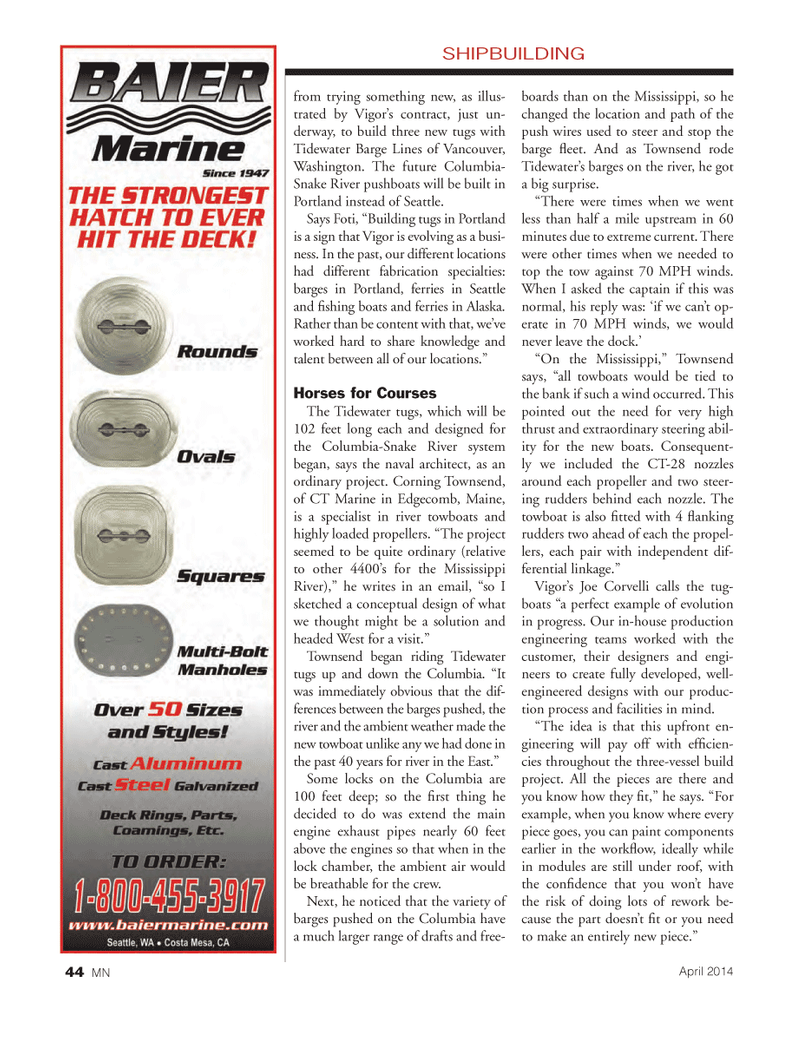
Page 44: of Marine News Magazine (April 2014)
Shipyard Report: Construction & Repair
Read this page in Pdf, Flash or Html5 edition of April 2014 Marine News Magazine
from trying something new, as illus- trated by Vigor?s contract, just un- derway, to build three new tugs with Tidewater Barge Lines of Vancouver, Washington. The future Columbia- Snake River pushboats will be built in Portland instead of Seattle. Says Foti, ?Building tugs in Portland is a sign that Vigor is evolving as a busi- ness. In the past, our different locations had different fabrication specialties: barges in Portland, ferries in Seattle and shing boats and ferries in Alaska. Rather than be content with that, we?ve worked hard to share knowledge and talent between all of our locations.? Horses for CoursesThe Tidewater tugs, which will be 102 feet long each and designed for the Columbia-Snake River system began, says the naval architect, as an ordinary project. Corning Townsend, of CT Marine in Edgecomb, Maine, is a specialist in river towboats and highly loaded propellers. ?The project seemed to be quite ordinary (relative to other 4400?s for the Mississippi River),? he writes in an email, ?so I sketched a conceptual design of what we thought might be a solution and headed West for a visit.? Townsend began riding Tidewater tugs up and down the Columbia. ?It was immediately obvious that the dif- ferences between the barges pushed, the river and the ambient weather made the new towboat unlike any we had done in the past 40 years for river in the East.? Some locks on the Columbia are 100 feet deep; so the rst thing he decided to do was extend the main engine exhaust pipes nearly 60 feet above the engines so that when in the lock chamber, the ambient air would be breathable for the crew. Next, he noticed that the variety of barges pushed on the Columbia have a much larger range of drafts and free- boards than on the Mississippi, so he changed the location and path of the push wires used to steer and stop the barge eet. And as Townsend rode Tidewater?s barges on the river, he got a big surprise. ?There were times when we went less than half a mile upstream in 60 minutes due to extreme current. There were other times when we needed to top the tow against 70 MPH winds. When I asked the captain if this was normal, his reply was: ?if we can?t op- erate in 70 MPH winds, we would never leave the dock.? ?On the Mississippi,? Townsend says, ?all towboats would be tied to the bank if such a wind occurred. This pointed out the need for very high thrust and extraordinary steering abil- ity for the new boats. Consequent- ly we included the CT-28 nozzles around each propeller and two steer- ing rudders behind each nozzle. The towboat is also tted with 4 anking rudders two ahead of each the propel- lers, each pair with independent dif-ferential linkage.? Vigor?s Joe Corvelli calls the tug- boats ?a perfect example of evolution in progress. Our in-house production engineering teams worked with the customer, their designers and engi- neers to create fully developed, well- engineered designs with our produc- tion process and facilities in mind. ?The idea is that this upfront en- gineering will pay off with ef cien-cies throughout the three-vessel build project. All the pieces are there and you know how they t,? he says. ?For example, when you know where every piece goes, you can paint components earlier in the work ow, ideally while in modules are still under roof, with the con dence that you won?t have the risk of doing lots of rework be- cause the part doesn?t t or you need to make an entirely new piece.? SHIPBUILDINGApril 201444 MNMN April14 Layout 32-49.indd 44MN April14 Layout 32-49.indd 443/20/2014 11:54:27 AM3/20/2014 11:54:27 AM

 43
43

 45
45
